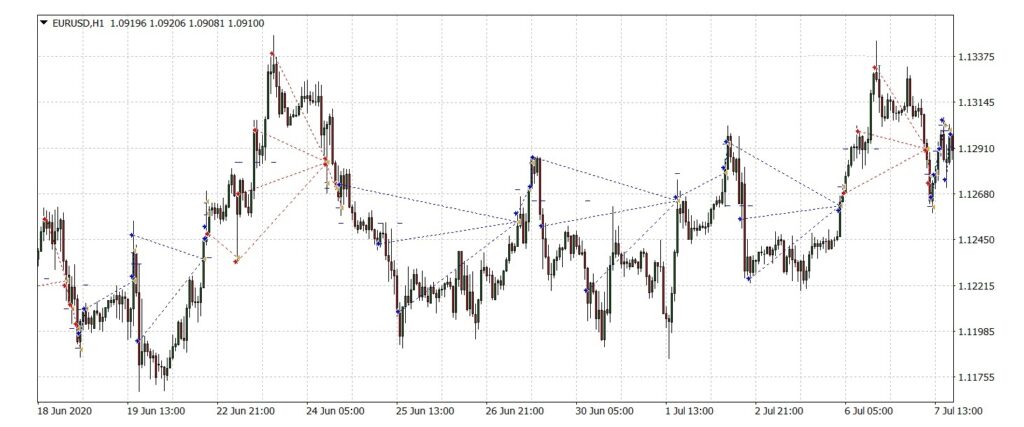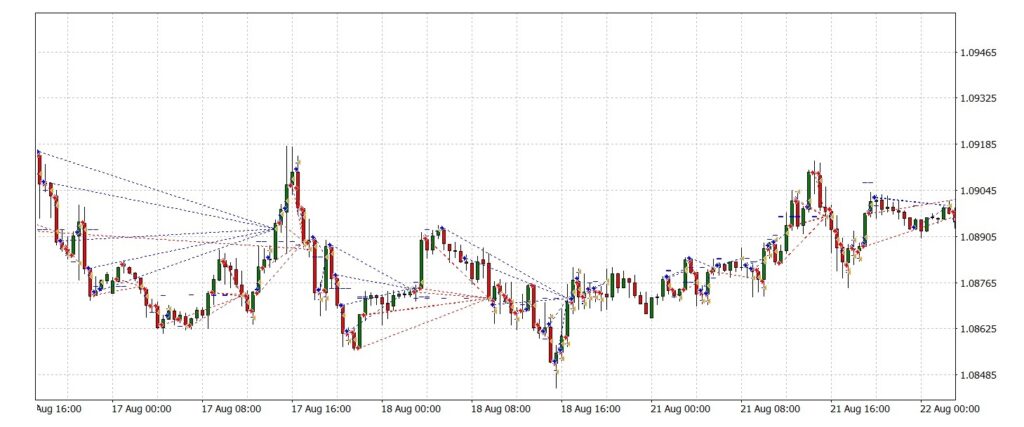
- Eugene Steiner
- Updated : April 20, 2025
Today, we’re peeking into the world of day traders and their playbook — the real strategies for forex trading that people are actually using. We’ve checked actual trader accounts to see which methods are most popular. From zigging when the market zags with counter-trend trades to quick wins with scalping and the classic trades with support and resistance levels. Oh, and there’s something about making moves at just the right time of day that’s pretty clever, too. Whether you’re in the game or just fascinated by the wild world of forex, you’ll want to stick around for this one. So, let’s roll up our sleeves and jump right in!
What Is Day Trading All About?
Based on our personal experience and the analysis of social media, the absolute majority of retail traders engage in day trading. It is as an umbrella term that encompasses a variety of strategies used to trade financial instruments within the same trading day. For the average Joe without the help of trading robots, this method often feels like gambling on a slot machine: lots of action and a rush of adrenaline, but profits are often miniscule.
The math and probability aren’t in the trader’s favor. Think about it – betting on red or black in a casino gives you a 50/50 shot, but in Forex, the odds are even slimmer. Over the years, while working for forex brokers, we have seen retail traders do all kinds of silly things. In fact, we even wrote a mini study. So if you want to know exactly why retail traders lose, you may want to check it out.
Retail Traders: A Pattern of Losing
The absolute majority of retail traders engage in day trading, employing various strategies, which we are going to review below. Right off the bat, whenever a retail trader opens an order, it puts them at a disadvantage. How so? Because spreads and commissions, baby! Plus, traders have to nail both the direction of the market and the timing of their moves. With all these hurdles, it’s way more likely to lose than win, and yes, many do lose – some even dive in with gusto.
However, a small group of day traders succeed, raking in profits that can soar into the tens of thousands. Sometimes it’s luck, sometimes is skill, sometimes it is a bit of both. In case of luck, the repeatability becomes an issue; skill, on the other hand, is replicable. Over the years, we have seen people who have been able to demonstrate both, as evidenced by prolonged winning streaks.
When Skill Meets Luck
The typical successful day trader often starts as a “mystery” client. At least that’s what we used to call them. They would show up out of nowhere, ask our support team really strange questions. And then bam, suddenly they open 3-5 trading accounts, each loaded with 40-50 thousand dollars or its crypto equivalent. They dive into day trading on all fronts, managing all these accounts simultaneously. It’s common to see them mirror the same trades across each account, thanks to trade copiers focusing on the same currency pairs. Then, about two or three days later, they wrap things up in a blink eye and disappear.
All accounts are emptied, and profits and initial deposits are withdrawn to the last cent. Soon after, the cycle might restart, sometimes with the money coming from someone else, say a brother-in-law. This trading blueprint is especially favored by Chinese traders. It involves making quick profits, often from trading gold or more exotic currencies like the MXN, before making a swift exit.
Scalping: One of the Most Popular Strategies for Forex Trading
One of the most popular strategies among novice retail traders is scalping—which is actually an umbrella term. This family of forex trading strategies revolves around making quick, short-term trades. It’s a pure day trading technique. Traders enter and exit positions rapidly, often within just 1 to 3 seconds, capturing small profits from minor price fluctuations. Think of it as grabbing a few dollars per lot repeatedly throughout the trading day.
People often confuse scalping with pipsing, but they’re distinct approaches. With pipsing, traders might hold a trade for several minutes or even a few hours if the market moves against them. Both scalping and pipsing focus on capturing tiny profits, often just a few pips—sometimes barely covering the spread. Due to the extremely fast pace, many retail traders use automated trading robots to implement scalping strategies. However, pipsing can comfortably be managed manually.
The main drawback of these strategies is the negative impact of spreads and commissions, which quickly erode profits. For this reason, retail traders typically choose currency pairs with lower spreads and higher liquidity, such as EUR/USD. This preference partly explains why EUR/USD is the most actively traded pair in the over-the-counter forex market.
While scalping has various methods to achieve profitability—something we’ll explore in more detail in upcoming posts—one of its biggest challenges is poor repeatability. It relies heavily on extremely short-term market inefficiencies, which can quickly change or vanish. Market conditions such as volatility, liquidity, spreads, and slippage continuously fluctuate. Even minor changes can render a previously profitable scalping strategy ineffective. Moreover, competition among high-frequency traders and algorithmic systems reduces the number of exploitable short-term opportunities, making it difficult for scalpers to replicate their success over longer periods.
How Does News Trading Work?
Forex trading strategies from this family specifically aim to capitalize on sharp market movements triggered by major economic news and events, which can significantly influence currency rates. Although news trading seems similar to fundamental analysis, it’s distinct. News traders enter positions immediately before, during, or right after economic data releases, taking advantage of heightened market volatility. Commonly traded events include interest rate decisions, employment reports, and GDP announcements, all capable of causing swift and substantial currency fluctuations.
However, there’s a tricky side to news trading—currency pairs don’t always react predictably to these announcements. Even when the news aligns with market expectations, currencies can behave unpredictably due to speculative positioning, liquidity shifts, market sentiment, or institutional intervention. Additionally, slippage and widened spreads during high-volatility periods can reduce the effectiveness of a previously successful approach. This sudden volatility can create a “storm,” triggering stop-loss orders and potentially causing significant losses. Consequently, strategies that were profitable during one event might not work consistently across similar future events, making repeatability a significant challenge.
We knew one trader who consistently made just two or three trades each month, focusing solely on high-impact economic events. Starting with around USD 10,000–15,000 in his account, he regularly netted an additional USD 3,000–4,000 monthly by leveraging just these few news releases. But is there a method to the madness? We’ll explore the detailed methods for analyzing economic data and building effective news trading strategies in upcoming articles.
Overlapping Trading Sessions
These strategies target price movements during overlapping trading sessions, particularly focusing on two key moments: the start of the American session at 8 a.m. EST and the end of the trading day at 5 p.m. EST, known as the rollover period. Traders often concentrate on the 30 minutes before and the 60 minutes after these times (in Central European Time) to capitalize on heightened liquidity and volatility, aligning well with the short-term nature of day trading.
Understanding the Rollover Period
The rollover marks the transition from one trading day to the next. During this window, significant behind-the-scenes activities occur among banks, prime brokers, and other market participants. Savvy traders may exploit any anomalies during this period for quick gains. For instance, spreads at prime brokers might momentarily narrow significantly, only to widen shortly after.
Profiting from Broker Infrastructure Anomalies
We’ve observed traders generating quick profits by leveraging in-depth knowledge of FX broker infrastructure. However, whether these profits can be withdrawn is another matter. While modest, infrequent gains might go unnoticed, substantial and recurrent earnings could prompt brokers to scrutinize and potentially invalidate them. To mitigate this risk, some traders distribute large deposits across multiple accounts, though brokers often monitor all accounts linked to a specific user profile.
Ethical and Regulatory Considerations
It’s important to note that profiting by exploiting system vulnerabilities is considered unethical and potentially fraudulent. Brokers have the right to reverse such trades, and regulatory bodies typically support these actions to maintain market integrity.
Counter Trend Day Trading
These forex trading strategies aim to capitalize on price reversals by entering or exiting the market at perceived peaks or troughs. This approach is popular among traders and can be applied to day trading as well as mid- to long-term strategies.
Many trading robots, or Expert Advisors (EAs), employ this logic. Typically, these bots initiate trades against the prevailing trend. However, trends take time to develop, and prices may fluctuate significantly before a new trend is confirmed. By the time a trend is evident, a substantial portion of the movement may have already occurred. Consequently, many bots enter positions without waiting for definitive trend confirmation, which can result in trading against the actual market direction.
Martingales and Grids
These counter-trend strategies are commonly implemented through Martingale and Grid systems:
- Martingale Strategy involves increasing the trade size after each loss, aiming to recover previous losses and gain a profit when a trade eventually succeeds. For example, if a trade results in a loss, the next trade is placed with a larger volume. While this can be effective in markets without strong trends, it carries significant risk, as a series of losses can lead to substantial drawdowns.
- Grid Strategy places buy and sell orders at predetermined intervals above and below a set price, creating a grid of orders. The strategy profits from market volatility, as it captures gains from price fluctuations within the grid. Unlike Martingale, Grid strategies typically use fixed trade sizes, but they can also accumulate losses if the market trends strongly in one direction without retracing.
Both strategies share similarities in that they involve multiple open positions and aim to profit from market reversals. However, they differ in trade sizing and risk management approaches.
Take a good look at the screenshot below. Every subsequent order placed by Expert Advisors based on Martingale has the volume larger than the previous one.

Grid and Martingale strategies are very similar. Grid-based Expert Advisors open orders of approximately the same size.

Blue dots on both images represent buy orders, and red dots represent sell orders. That EA closes all orders almost simultaneously, slightly above the break-even price. Doing this manually is tough, so it’s often left to trading robots (Expert Advisors).
Martingales and Grids are the strategies that retail traders use most frequently. The main difference is how each one of them places at each new level. With Martingales, each new order is opened with a larger volume than the previous one. Meanwhile, Grid strategies allow orders to be opened at new levels with the same volume. Additionally, Grids can open combined buy and sell orders within the same market movement. On the other hand, Martingales only open orders of one type per trading cycle. This is because Martingales require an even larger volume with each new level, significantly increasing the margin – the collateral amount.
The Hidden Danger of Martingale: Exponential Risk
Martingale strategies might look clever on the surface. After all, doubling your trade size after each loss seems like a surefire way to recover quickly and end up in profit. But this is exactly where the danger lies. Martingale relies on the assumption that the market will eventually reverse in your favor. If that doesn’t happen soon enough, the losses start compounding exponentially. One losing streak can balloon your exposure so fast that even a well-funded account can get wiped out. The risk-to-reward ratio is completely skewed—traders take massive risks just to gain a small win. That’s why seasoned traders treat Martingale with extreme caution, if not avoid it altogether.
Grids: Great in Theory, Risky in Trends
Grid strategies are designed to profit from price fluctuations by placing buy and sell orders at regular intervals above and below the current market price. When the market bounces around, the grid collects profits from both directions. But here’s the catch—if the market starts trending strongly in one direction and doesn’t come back, grid positions on the wrong side just keep piling up. Without proper exits or risk controls, a trader can quickly find themselves buried under a mountain of losing trades. In trending markets, a grid strategy without stop-losses is a recipe for disaster.
The Psychological Trap of Recovery Systems
Both Martingale and Grid strategies appeal to a trader’s desire to always be right—or at least, never close a trade in loss. They sell the dream of recovery: if you just hang on long enough, the market will turn around. But in reality, this leads to a dangerous psychological trap. Traders keep increasing position sizes or letting losses run, convincing themselves they’re just one trade away from breaking even. Meanwhile, risk exposure balloons, and the stress of seeing negative equity climb higher can be overwhelming. These strategies often feel safe—until they aren’t.
Trend Trading
Trend Trading is exactly what it sounds like. Forex trading strategies of this type follow the market’s current trend. The goal is to take positions that align with the market’s movements, which makes it adaptable to different trading styles and time horizons, depending on the trader’s goals, risk tolerance, and analysis of market dynamics. It is a versatile strategy that traders can apply over various timeframes, including intraday (within a single trading day), medium-term (days to weeks), and long-term (months to years).
These strategies are smart and have proven to work well. Yet, traders often find it hard to stick to with discipline. We plan to dive deeper into Trend Trading in a separate post, breaking it down with examples and giving it the in-depth look it deserves.
Indicator-Based Trading
These forex trading strategies rely on technical indicators, such as moving averages and the Relative Strength Index (RSI), MACD etc to guide traders on when to enter and exit trades. Strategies from this family are also universal in nature and many retail traders adapt them for intraday trading.
About Effectiveness of Technical Indicators
Technical indicators, such as moving averages, RSI, and MACD, have been widely used by forex traders to inform entry and exit decisions. Studies have shown that these indicators can be effective under certain market conditions.
The efficacy of technical indicators is strongly influenced by market conditions. For instance, moving averages, MACD, and ADX tend to perform well in trending markets, while oscillators like RSI and Stochastic are more effective in ranging markets.
Combining multiple technical indicators can enhance trading performance. For example, using a combination of Bollinger Bands and the Average Directional Index (ADX) has been shown to improve the reliability of trading signals.
Strategies for forex trading using indicators had a huge following up until about 2012. Back then, trading forums were alive with chatter about various strategies using various indicators. There were endless debates on the superior choice: moving averages or combining stochastics with parabolics. However, this kind of debate has cooled over the years. Nowadays, the community’s interest has shifted more towards fine-tuning the performance of specific trading advisors, such as the Phoenix EA we touched on before. This includes a keen interest in those utilizing Martingale strategies.
Support and Resistance: Classics with Modern Challenges
Relying on support and resistance levels is by far one of the most widely used strategies for trading forex and other markets. The idea here is to identify key price points where the market has historically shown a tendency to reverse or stall. These levels act as psychological barriers, guiding traders in making entry and exit decisions. The strategy’s longevity speaks to its foundational role in technical analysis.
Traders often categorize themselves based on their approach to these levels. Short-term traders might capitalize on breakouts when the price moves beyond established support or resistance, while long-term traders may use these levels in conjunction with trend lines to forecast future price movements.
This method isn’t exclusive to day trading; it’s also prevalent among swing and position traders who may hold positions for extended periods, leveraging these levels to inform their strategies.
While support and resistance levels are widely used, their identification can be highly subjective. Different traders may interpret chart patterns differently, leading to inconsistencies. Moreover, the effectiveness of these levels can vary across different market conditions, making their predictive power less reliable in certain scenarios. It’s essential to combine this strategy with other analytical tools and risk management practices to enhance its effectiveness.
We took a deep dive into the nuances of this strategy in one if our posts. We explored techniques to identify these levels more objectively and integrate them into a comprehensive trading plan. Check it out here.
Candlestick Patterns
Candlestick pattern recognition, once a cornerstone of forex trading strategies, involves identifying specific formations like the “Hammer” or “Inverse Head and Shoulders” on price charts to inform trading decisions. This approach has been adaptable to both day trading and longer-term strategies, offering traders a visual method to gauge market sentiment.
However, since around 2012, the popularity of this method has waned. A significant challenge is the sheer volume of patterns traders are expected to recognize and interpret. The cognitive load of memorizing and accurately identifying these patterns has led many to seek simpler, more straightforward trading strategies. Consequently, candlestick pattern analysis has become more of a niche skill among dedicated forex enthusiasts.
The Subjectivity and Limitations of Pattern Recognition
A critical issue with candlestick patterns is their subjective nature. Different traders may interpret the same pattern differently, leading to inconsistent decision-making. This subjectivity undermines the repeatability and reliability of such strategies. Moreover, the internet is replete with “cheat sheets” that promise quick profits by memorizing certain patterns. These resources often perpetuate financial misconceptions, giving novice traders the false impression that mastering these patterns guarantees profitability.
Importantly, academic research has cast doubt on the efficacy of traditional candlestick patterns. For instance, a study analyzing 13 years of data across major currency pairs found that Doji patterns were unreliable indicators of reversals in the forex market. The study introduced a new pattern, MIDDAM, which significantly outperformed traditional patterns in predictive accuracy and profitability.
Furthermore, the interpretation of candlestick patterns lacks a standardized framework, making it challenging to test their effectiveness objectively. This lack of empirical validation suggests that relying solely on these patterns may not provide a consistent trading edge.
Summary Table: Forex Day Trading Techniques and Their Risks
| Strategy | Timeframe | Risk Level | Key Challenge | Best for... |
|---|---|---|---|---|
| Scalping | Seconds | High | Spread/slippage | Fast-paced traders |
| News Trading | Minutes | High | Unpredictable reactions | Event-based traders |
| Grid Strategy | Hours–Days | High | Trending markets | Range traders |
| Martingale | Any | Extreme | Drawdowns, compounding | Not recommended |
| Trend Trading | Any | Medium | Discipline | Longer-term setups |
| Candlestick Patterns | Any | Variable | Subjectivity | Pattern aficionados |
📌 Frequently Asked Questions About Day Trading Strategies
Profitability depends on skill, strategy, and market conditions. News trading and trend following can be lucrative, while Martingale carries extreme risk.
Scalping targets quick profits with many small trades. Trend trading takes a slower, longer-term approach. The best one depends on your style and risk appetite.
Most retail traders lose due to emotional decisions, lack of a proven strategy, poor risk management, and the cumulative effect of spreads and commissions.
Yes, they are legal but highly discouraged. Brokers may monitor and block such strategies, especially when used to exploit system inefficiencies or margins.
Support/resistance and basic trend-following strategies are best for beginners. They're easier to understand and apply while still offering learning depth.
Final Thoughts
At the end of the day, day trading is a game of probability, discipline, and constant adaptation. We’ve walked through the most commonly used forex trading strategies—from the lightning-fast world of scalping to the psychological rollercoaster of Martingales, and everything in between. Each one comes with its own promises and pitfalls.
What’s clear is that no single strategy guarantees success. Many of them suffer from the same fundamental issues: high risk, poor repeatability, and a steep learning curve. Some strategies, like trend trading and support/resistance, offer more structure and long-term potential, while others—especially Martingale and Grid systems—can be downright dangerous if misused.
Retail traders often come in hot, full of ambition, and sometimes illusions. A few walk away with profits. Most, however, walk away with lessons. If there’s one thing to take away from all this, it’s that surviving in the forex market requires more than pattern recognition or indicator mastery. It demands a realistic understanding of risk, a strong grasp of money management, and the humility to know that even the best setups can fail.
RESOURCES USED IN THIS ARTICLE:
- Forex Trading Indicators: What are Technical Indicators in Forex? by Dukaskopy.
- Effectiveness of Bollinger Bands
- Enhancing FOREX Market Predictions: A Comparative Study of Candlestick Patterns and the MIDDAM Patterns
- Martingale Probability Theory
- Grid Trading by Investopedia
Last time, we dug into the Phoenix EA story, examining its inner workings and pinpointing why it fell short. Coming up? We’re going to get into the nitty-gritty of scalping and pipsing.
DISCLAIMER: This article is for educational purposes only and does not constitute financial advice. Trading forex involves significant risk and may not be suitable for all investors.



